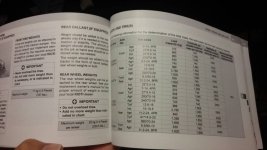aTexasYankee
Member
I searched. Quite a bit, actually, and couldn't find a thread specific to what I'm asking, only responses in other topics.
I'm less than a year and under 100 hours on my Kioti. It feels a little "tippy" to me at times and I'm usually pretty good at sensing when balance is a little too far off. In reading lots of other threads I've seen where adding weight, low, can help with stability. That makes sense, but I not sure how to go about it and which is the most effective, both in practice and economically. I also don't want any extra wear and tear or maintenance if I can avoid it.
There's weights you can bolt on to the tires? How does that's work? Like an steel hubcap? Cost?
Weight installed onto the draw bar? Cost? Will this interfere with any 3pt attachments?
Filling tires with liquid? I'm already out on the calcium stuff... But the windshield washer fluid or RV coolant, how well does that work? How easy is this to do DIY and what damage can I cause going this route?
Will I see any significant draw back to adding weight? My uses are light dirt work, driveway maintenance, digging swales with BB, landscaping rake, mowing a few acres of grass (RC for now, but will eventually get a finish mower), and general wheelbarrow uses. I get muddy on parts of the property, should I avoid extra weight? Will the extra weight tear up my lawn when mowing more?
Thanks!
I'm less than a year and under 100 hours on my Kioti. It feels a little "tippy" to me at times and I'm usually pretty good at sensing when balance is a little too far off. In reading lots of other threads I've seen where adding weight, low, can help with stability. That makes sense, but I not sure how to go about it and which is the most effective, both in practice and economically. I also don't want any extra wear and tear or maintenance if I can avoid it.
There's weights you can bolt on to the tires? How does that's work? Like an steel hubcap? Cost?
Weight installed onto the draw bar? Cost? Will this interfere with any 3pt attachments?
Filling tires with liquid? I'm already out on the calcium stuff... But the windshield washer fluid or RV coolant, how well does that work? How easy is this to do DIY and what damage can I cause going this route?
Will I see any significant draw back to adding weight? My uses are light dirt work, driveway maintenance, digging swales with BB, landscaping rake, mowing a few acres of grass (RC for now, but will eventually get a finish mower), and general wheelbarrow uses. I get muddy on parts of the property, should I avoid extra weight? Will the extra weight tear up my lawn when mowing more?
Thanks!
